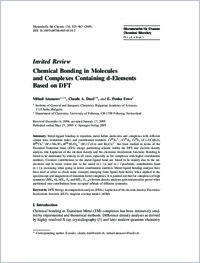Chemical bonding in molecules and complexes containing d-elements based on DFT
- Atanasov, Mihail Institute of General and Inorganic Chemistry, Bulgarian Academy of Sciences, Sofia, Bulgaria - Department of Chemistry, University of Fribourg, Switzerland
- Daul, Claude Department of Chemistry, University of Fribourg, Switzerland
- Penka Fowe, Emmanuel Department of Chemistry, University of Fribourg, Switzerland
-
23.05.2005
Published in:
- Monatshefte für Chemie / Chemical Monthly. - 2005, vol. 136, no. 6, p. 925-963
DFT
energy decomposition analysis (EDA)
laplacian of the electron density
electronic localization function (ELF)
angular overlap model (AOM)
English
Metal–ligand bonding in transition metal halide molecules and complexes with different central ions, oxidations states, and coordination numbers: CrIII X₆³⁻, CrIVX₄, CrIIX₂ (X = F,Cl,Br,I), MIIICl₆³⁻(M = Mo,W), MIII (H₂O)₆³⁺(M = Cr,Co) and Re₂Cl₈²⁻ has been studied in terms of the Extended Transition State (ETS) energy patitioning scheme within the DFT and electron density analysis (the Laplacian of the electron density and the electronic localization function). Bonding is found to be dominated by ionicity in all cases, especially so for complexes with higher coordination numbers. Covalent contributions to the metal–ligand bond are found to be mainly due to the nd-electrons and to lesser extent due to the metal (n + 1)s and (n + 1)p-orbitals, contributions from (n+1)s increasing when going to lower coordination numbers. Metal–ligand bonding analysis have been used in order to check some concepts emerging from ligand field theory when applied to the spectroscopy and magnetism of transition metal complexes. It is pointed out that for complexes of high symmetry (MX₆, Oh, MX₄, Td, and MX₂, D∞h) electron density analyses gain interpretative power when partitioned into contributions from occupied orbitals of different symmetry.
- Faculty
- Faculté des sciences et de médecine
- Department
- Département de Chimie
- Language
-
- English
- Classification
- Chemistry
- License
-
License undefined
- Identifiers
-
- RERO DOC 5178
- DOI 10.1007/s00706-005-0310-2
- Persistent URL
- https://folia.unifr.ch/unifr/documents/300024
Statistics
Document views: 147
File downloads:
- Document: 262
